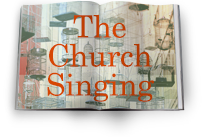My Congregation Barely Sings; How Can I Help?
Spend some time with members of a Khosa church in South Africa, and you will quickly discover how wonderfully they sing. No instruments. No microphones. One individual leading, the rest following. Many hands clapping. And how they join their voices in full-throated praise!
This article is not written for them. It’s written for a traditional Western church. Westerners are accustomed to professional-quality and performance-oriented music. And for better or worse, this affects what Christians expect musically when we walk into the church gathering. Unless a church deliberately pushes in an alternative direction, we expect the music to demonstrate the same quality of performance as what we hear on the car radio or through our Mp3 ear buds. Anything less can sound clunky, tacky, even embarrassing.
What’s more, there are few places in contemporary Western culture where people learn to sing together. Maybe at a Christmas event? Or in the seventh-inning stretch at Wrigley Field?
Church leaders underestimate how deliberately they must push against these cultural trends to get their church singing; to teach them that the untrained but united voices of the congregation make a far better sound than the Tonight Show band; to teach them that singing loudly in the presence of other people is not awkward; to teach them that all our emotions don’t have to be individually spontaneous to be worthy, but that there is place to guide and conform our individual emotions to the group’s activity.
If church leaders want congregations that will really “speak to one another in psalms, hymns, and spiritual songs” (Eph. 5:19), they will have to work at it. They will have to try things that might seem strange or unnatural for people who are accustomed to sitting quietly and watching the performance on stage. Here are a few tips, many of which, no doubt, fall into the realm of prudence.
1. Teach the congregation the importance of worshipping God in song. Just as Christians must be taught the importance of prayer and other spiritual disciplines, so they must learn from Scripture how God intends for them to sing. When the Word of God dwells in us richly, singing is the natural result (see Col. 3:16). If God sings over us in happy song (Zeph. 3:17), we who reflect our Creator should sing in return.
2. Encourage thoughtful, purposeful singing through private and public prayer. How easy it is to honor God with our lips while our hearts are far from him (Is. 29:13; Matt. 15:8)! So pray privately and publicly against thoughtless and hypocritical singing.
3. Make sure the congregation knows why they are singing the chosen song. If it’s a prayer, briefly remind them. If it’s a song of commitment, point that out. If it reflects the preached message from God’s Word, make that clear. Songs that are chosen just because they are favorite song of the song-chooser are often not well-sung. Although congregations are generally compliant enough to sing whatever song is suggested, they will sing it more enthusiastically if they know why they are singing that particular song. Help them to care about singing “in spirit and in truth.”
4. Choose “congregational” rather than “performance” songs. Here is a general (not absolute) principle: the more a song depends on the musical accompaniment and cannot be sung by a couple of children in the car on the way home, the more performance-oriented and less congregational it probably is. Congregational songs tend to have singable and memorable melodies. Just because a Christian artist has created something wonderful does not mean it is appropriate for the congregation. The melody may not be very melodic. It may be too high, too low, or wide of range. It may be too rhythmic, perhaps syncopated in a way that’s difficult for untrained singers. It may be too complex through bridges, tags, or multiple keys. Such music might sound wonderful with the recorded accompaniment. Maybe the praise band can perform it just fine. But the more a congregation needs the musicians up front to get through a song, the more you can expect them to mouth the words while watching the band do its thing.
5. Please, oh please, turn up the lights. Keeping stage lights bright while dimming lights among the people turns the people into an “audience” and everyone on stage into performers. It makes the whole event mimic the movie theater or the concert hall. Keeping the entire room lit up, however, suggests that everyone is called to participate in the “performance” before an “audience” of one—God.
6. Please, oh please, turn down the musical accompaniment. You don’t want your electric guitars or your organ, your drums or your microphoned choir, to drown out the sound of the congregation singing. We might even say the loudest sound in a room should be the congregation. Lead singers might sing loudly on the first verse of a song, but then pull back a touch on subsequent verses. Good accompaniment accompanies. Facilitates. Encourages. It does not attract or overwhelm. If a small group or choir is leading, they should be an aural microcosm of the congregation. Let their volume be natural and without too much amplification. If they have prepared the hymn in rehearsal they will “lead” by their sound.
7. Consider the dangers of performance rehearsals, “excellent” music, and heavy instrumentation. There is a place for musical rehearsal. But why are you rehearsing? To what end? Musical rehearsals often involve the insertion of creative elements that make for good performances, but not for congregational singing. Musicians and singers should use any rehearsal time to ask themselves how to best facilitate congregational singing, not be impressive. The common focus on “excellence” and “quality” can, ironically, distract musicians from seeking to serve the congregation because “excellence” is unthinkingly defined in terms of performance. What would it instead mean to aim to facilitate excellently, not to perform excellently. By the same token, elaborate instrumentation can sometimes squelch congregational singing. Mere and acoustic instrumentation tends to help singing.
8. Look for a balance between new songs and old songs. On the one hand, people sing well when singing an old and beloved song. On the other hand, old songs can wear out, which can lead to thoughtless singing. On the one hand, songs that are new to a congregation (whether recently composed or not) are harder to sing. On the other hand, a congregation’s musical repertoire should grow as the congregation grows in maturity and depth. Congregations, like people, go through different seasons, and new songs help it to grow through those seasons. All these hands mean that helping people to sing well involves both new and old songs, and figuring out the balance for your church. Never be closed to learning new songs, whether they are newly composed or old songs that are new to you. And teach those new songs more than once.
9. Use songs that represent a broad range of human experience and emotion. If all a church’s music is exultant and gladsome, much of your church’s singing will be inauthentic and affected. How true to life are they lyrics of “I Hear the Words of Love”: “My love is ofttimes low, / My joy still ebbs and flows, / But peace with Him remains the same, / No change my Savior knows.” Or that frank admission from “Come Thou Fount”: “Prone to wander, Lord, I feel it, / Prone to leave the God I love…” A church’s hymnody, like the Psalter, should have words for happy Christians, sad Christians, tempted Christians, and all the in-between Christians. Along these lines, a congregation is served by having a repertoire of 300 songs rather than 30. Life is complex and diverse. So should our worship be.
10. Vary the way a song is sung. Just as a preacher might speak the same words with a different tone between one Sunday and the next, adjusting for the mood of the day or the sermonic context in which the words are spoken, so a song might be led differently at different times. The dynamics of the accompaniment might vary. Maybe the volume rises; maybe it falls. Maybe that third stanza is sung quietly, maybe vigorously. Maybe a key change, maybe not. Maybe a cappella, maybe not. Certainly the text of a song should shape the mood of the accompaniment, but so can the mood of the church’s life, or the place it occurs in the church service.
11. Where possible, arrange chairs or pews with some facing each other and not just the stage. Singing is a “team” effort, and often the only part of the worship that is a visible expression of togetherness. This is one way to remember the fact that Paul says to “speak to one another in psalms, hymns, and spiritual songs” (Eph. 5:19). There is nothing wrong with closing one’s eyes when singing, to be sure, but the picture painted by Paul sounds like people are looking at one another! Church is not the place for a turbo-charged quiet time.
12. Consider the room’s acoustics. Bad acoustics hurt congregational singing probably more than you realize. Are the floors entirely carpeted? Limit carpet to the aisles. Are there acoustic tiles on the ceiling? Remove them and replace with solid plaster. Heavy curtains? Take them down. Fully padded pews? Any chance of removing all padding except the seat? If your worship space is unusual in any way and needs help, maybe hire a professional acoustician to consult for what you can do to improve the reverberation time and limit unpleasant echoes.
Warning: acousticians will always assume you want “to improve the acoustics” in terms of what is projected from the platform. Many ask for an auditorium with “dead” acoustics in the audience so that coughing and extraneous noise is not heard during a concert. But you must inform them that you want improved congregational singing. Worship is not a concert, and the congregation is not an audience. Let them be heard through live acoustics. Why do people like to sing in the shower? Because the acoustics amplify our sound.
13. Perhaps place musicians and singers to the side for a season. Every room and congregational culture is different. Placing musicians and singers to the side might in some circumstances hinder congregational singing because the congregation needs stronger leadership. But if your congregation has fallen into a performance culture and orientation, where feasible, considering placing song leaders to the side. There was a good reasons some older churches placed their choirs in the balcony–so that they would be heard and not seen. When the song leader’s stage presence yields a performance culture, God is less seen and heard.
14. Model enthusiastic singing. Whether the elders, staff, and deacons are sitting on a platform or in the congregation, they should model enthusiastic and appropriately-loud singing. Off-key singing is better than no singing. The pastor who is still looking over sermon notes during the singing is saying by example, “Singing in our worship is not that important!” In a culture that sometimes equates masculinity with the stoicism of a Clint Eastwood-like character, modeling enthusiastic singing is especially important for male leadership.
15. Print the music, pick songs with good parts, and look for other ways to promote musical literacy. Musical literacy is not what it used to be, thanks to declining music education in schools. But even if ten percent of the church sings the parts, everyone’s singing will be invigorated. People talk about the advantages of “looking up,” which reading an overhead screen requires. But why then is it that all the churches looking at screens don’t seem to sing as well as an older generation of churches staring down at their hymnals? Perhaps it’s time for churches to think about hymnals again, or at least to start printing music in their bulletins. Pick music with good parts, and make sure any choir or song leaders sing the parts.
16. Hold a singing class. Following the example of the composer of “When I Survey the Wondrous Cross,” Lowell Mason, who created “Singing Schools” in the church, Justin Leighty, a member of Third Avenue Baptist Church in Louisville, offers his own church a monthly hymn singing class. They meet the first Sunday of every month for 45 minutes before the evening service. Attendees are grouped by their parts like a choir, and they practice music basics: “This is a quarter note; this is a whole note. Here’s where the tenor line is: when it goes down, you go down, when it goes up, you go up…etc.”
17. Occasionally sing a cappella (unaccompanied). Maybe the third verse; maybe the fourth. Or maybe even a whole song, with a piano or guitar starting the piece and then bridging transitions. And don’t waste you’re a cappella singing on melody-only songs; sing it when there are parts that are good and well known. A cappella singing helps the congregation to hear themselves and rely solely on their combined voices to sing at a volume that says they believe what they are singing! Slow the tempo down a bit and free the congregation to engage every part of their body, soul, and spirit in the song.
18. Regularly remind the congregation that they are the primary instrument in corporate worship. If they don’t sing with gusto, musical worship won’t happen. That doesn’t mean acting like a cheerleader at a pep-rally: “Okay, let’s really sing…I want to hear you…I know you can sing louder!” Such leadership detracts from the seriousness of the music, and doesn’t treat their singing as a genuine spiritual expression of love, thanksgiving, and praise. Ultimately, congregational singing should be as natural as words of awe before an unusual sunset, or words of mourning with a hurting friend. Still, congregations must be taught that it is their responsibility to sing, and to teach one another through song. They must be taught to gather expecting to sing.
Mark Dever and Matt Merker contributed to this article.









